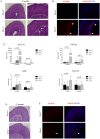Kisspeptin deficiency leads to abnormal adrenal glands and excess steroid hormone secretion
- PMID: 33089319
- PMCID: PMC7906779
- DOI: 10.1093/hmg/ddaa215
Kisspeptin deficiency leads to abnormal adrenal glands and excess steroid hormone secretion
Abstract
Knockout mice for the kisspeptin receptor, Kiss1r (Kiss1r-/-) and its ligand kisspeptin, Kiss1 (Kiss1-/-) replicate the phenotype of isolated hypogonadotropic hypogonadism (IHH) associated with variants of these genes in humans. A recent report suggests that kisspeptin may be involved in human fetal adrenocortical development and function. Herein, we characterized the adrenal function and morphology in Kiss1-/- mice that do not go through normal puberty. Two fetal markers were expressed in eosinophilic cells potentially derived from the X-zone that should disappear at puberty in male mice and during the first pregnancy in female animals. Although the hypercorticosteronism observed in Kiss1-/- females corrected overtime, hyperaldosteronism persisted at 14 months and correlated with the overexpression of Star. To determine if KISS1 and KISS1R genes are involved in the development of primary aldosteronism (PA) and hypercortisolism [Cushing's syndrome (CS)] in humans, we sequenced these 2 genes in 65 patients with PA and/or CS. Interestingly, a patient with CS presented with a germline KISS1 variant (p.H90D, rs201073751). We also found three rare variants in the KISS1R gene in three patients with PA: p.C95W (rs141767649), p.A189T (rs73507527) and p.R229R (rs115335009). The two missense variants have been previously associated with IHH. Our findings suggest that KISS1 may play a role in adrenal function in mice and possibly adrenocortical steroid hormone secretion in humans, beyond its recently described role in human fetal adrenocortical development.
Published by Oxford University Press 2020.
Figures


Similar articles
-
Understanding the functions of kisspeptin and kisspeptin receptor (Kiss1R) from clinical case studies.Peptides. 2019 Oct;120:170019. doi: 10.1016/j.peptides.2018.09.007. Epub 2018 Oct 16. Peptides. 2019. PMID: 30339828 Review.
-
Mutations of the KISS1 gene in disorders of puberty.J Clin Endocrinol Metab. 2010 May;95(5):2276-80. doi: 10.1210/jc.2009-2421. Epub 2010 Mar 17. J Clin Endocrinol Metab. 2010. PMID: 20237166 Free PMC article.
-
Development-related changes in the expression of the ovarian Kiss1 and Kiss1r genes and their sensitivity to human chorionic gonadotropin in prepubertal female rats.J Reprod Dev. 2017 Aug 19;63(4):409-414. doi: 10.1262/jrd.2016-179. Epub 2017 May 27. J Reprod Dev. 2017. PMID: 28552864 Free PMC article.
-
[Kisspeptin and leptin in the regulation of fertility].Mol Biol (Mosk). 2015 Sep-Oct;49(5):707-15. doi: 10.7868/S0026898415050134. Mol Biol (Mosk). 2015. PMID: 26510589 Review. Russian.
-
The role of placental kisspeptin in trophoblast invasion and migration: an assessment in Kiss1r knockout mice, BeWo cell lines and human term placenta.Reprod Fertil Dev. 2024 Jul;36:RD23230. doi: 10.1071/RD23230. Reprod Fertil Dev. 2024. PMID: 38976640
Cited by
-
Current insight into the transient X-zone in the adrenal gland cortex.Vitam Horm. 2024;124:297-339. doi: 10.1016/bs.vh.2023.05.003. Epub 2023 Jul 12. Vitam Horm. 2024. PMID: 38408801 Free PMC article. Review.
-
Bibliometrics and visualization analysis of literature on male hypogonadism from 2000 to 2023: research focus and frontiers.Int J Impot Res. 2024 Jun;36(4):312-323. doi: 10.1038/s41443-023-00803-4. Epub 2023 Dec 5. Int J Impot Res. 2024. PMID: 38052978 Review.
-
Investigation of effect peripheral kisspeptin treatment on hypothalamo-pituitary-gonadal axis and hypothalamo-pituitary-adrenal axis in male rats.Biol Futur. 2024 Dec;75(4):477-486. doi: 10.1007/s42977-024-00241-3. Epub 2024 Sep 9. Biol Futur. 2024. PMID: 39249652
-
Primary unilateral macronodular adrenal hyperplasia with concomitant glucocorticoid and androgen excess and KDM1A inactivation.Eur J Endocrinol. 2024 Aug 30;191(3):334-344. doi: 10.1093/ejendo/lvae106. Eur J Endocrinol. 2024. PMID: 39171930 Free PMC article.
References
-
- Seminara, S.B., Messager, S., Chatzidaki, E.E., Thresher, R.R., Acierno, J.S., Jr., Shagoury, J.K., Bo-Abbas, Y., Kuohung, W., Schwinof, K.M., Hendrick, A.G. et al. (2003) The GPR54 gene as a regulator of puberty. N. Engl. J. Med., 349, 1614–1627. - PubMed
-
- Messager, S., Chatzidaki, E.E., Ma, D., Hendrick, A.G., Zahn, D., Dixon, J., Thresher, R.R., Malinge, I., Lomet, D., Carlton, M.B. et al. (2005) Kisspeptin directly stimulates gonadotropin-releasing hormone release via G protein-coupled receptor 54. Proc. Natl. Acad. Sci. U. S. A., 102, 1761–1766. - PMC - PubMed
-
- Katugampola, H., King, P.J., Chatterjee, S., Meso, M., Duncan, A.J., Achermann, J.C., Guasti, L., Ghataore, L., Taylor, N.F., Allen, R. et al. (2017) Kisspeptin is a novel regulator of human Fetal adrenocortical development and function: a finding with important implications for the human Fetoplacental unit. J. Clin. Endocrinol. Metab., 102, 3349–3359. - PMC - PubMed
-
- Pihlajoki, M., Gretzinger, E., Cochran, R., Kyronlahti, A., Schrade, A., Hiller, T., Sullivan, L., Shoykhet, M., Schoeller, E.L., Brooks, M.D. et al. (2013) Conditional mutagenesis of Gata6 in SF1-positive cells causes gonadal-like differentiation in the adrenal cortex of mice. Endocrinology, 154, 1754–1767. - PMC - PubMed
Publication types
MeSH terms
Substances
LinkOut - more resources
Full Text Sources
Medical
Molecular Biology Databases

